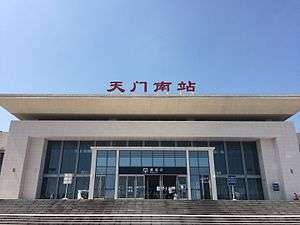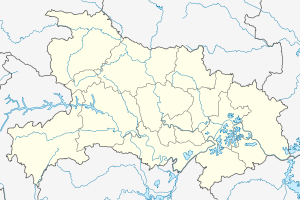Tianmen
| Tianmen 天门市 | |
|---|---|
| County-level & Sub-prefectural city | |
 Tianmen South Station Entrance Hall | |
.png) Location of Tianmen within Hubei and the PRC | |
 Tianmen Location of the city centre in Hubei | |
| Coordinates: 30°40′N 113°10′E / 30.667°N 113.167°ECoordinates: 30°40′N 113°10′E / 30.667°N 113.167°E | |
| country | People's Republic of China |
| Province | Hubei |
| Area | |
| • County-level & Sub-prefectural city | 2,622 km2 (1,012 sq mi) |
| • Urban (2018)[1] | 49 km2 (19 sq mi) |
| Elevation | 32 m (104 ft) |
| Population (2014) | |
| • County-level & Sub-prefectural city | 1,731,482 |
| • Density | 660/km2 (1,700/sq mi) |
| • Urban (2018)[2] | 650,000 |
| Time zone | UTC+8 (China Standard) |
| Website | 天门市人民政府门户网站 (translation: Tianmen City People's Government Web Portal) (in Simplified Chinese) |
Tianmen (simplified Chinese: 天门; traditional Chinese: 天門; pinyin: Tiānmén; literally: "sky gate") is a sub-prefecture-level city(or:county-level city in some ways) in central Hubei Province, People's Republic of China.
It is on the Jianghan Plain,on the west side of Wuhan (the biggest city of Central China, as well as the capital of Hubei) and the east of Jingzhou (a famous city in Chinese history). Formerly known as Jingling (竟陵), it was renamed to Tianmen in 1726 during the Qing dynasty. The name comes from the Sky Gate Mountains (meaning “tianmen” in Chinese) which lie northwest of the city.[3]
It is the hometown of Lu Yu, the writer of The Classic of Tea, who is respected as "the Sage of Tea" for his contribution to the tea culture. Tianmen has the largest population among the same level cities in Central China. It was honoured "National Civilized City" by Chinese government in 2014.
Ancient history
Prehistoric ancient settlements in the Tianmen area existed at least 7,000 to 8,000 years ago as evidenced by Shijiahe neolithic tribal ruins which include recent discoveries of stone (jade) devices, pottery, bone, mussels, as well as bronze articles and other artifacts, such as those in the original Tao Zu patrilineal cultural heritage period.[3]
Geography
Administrative divisions
| # | Name | Chinese (S) | ||||
|---|---|---|---|---|---|---|
| Subdistricts | ||||||
| 1 | Jingling Sundistrict | 竟陵街道 | ||||
| 2 | Qiaoxiang Subdistrict | 侨乡街道 (天门经济开发区) | ||||
| 3 | Yanglin Subdistrict | 杨林街道 | ||||
| Towns | ||||||
| 4 | Duobao Town | 多宝镇 | ||||
| 5 | Tuoshi Town | 拖市镇 | ||||
| 6 | Zhanggang Town | 张港镇 | ||||
| 7 | Jiangchang Town | 蒋场镇 | ||||
| 8 | Wangchang Town | 汪场镇 | ||||
| 9 | Yuxin Town | 渔薪镇 | ||||
| 10 | Huangtan Town | 黄潭镇 | ||||
| 11 | Yuekou Town | 岳口镇 | ||||
| 12 | Henglin Town | 横林镇 | ||||
| 13 | Pengshi Town | 彭市镇 | ||||
| 14 | Mayang Town | 麻洋镇 | ||||
| 15 | Duoxiang Town | 多祥镇 | ||||
| 16 | Ganyi Town | 干驿镇 | ||||
| 17 | Mawan Town | 马湾镇 | ||||
| 18 | Lushi Town | 卢市镇 | ||||
| 19 | Xiaoban Town | 小板镇 | ||||
| 20 | Jiuzhen Town | 九真镇 | ||||
| 21 | Zaoshi Town | 皂市镇 | ||||
| 22 | Hushi Town | 胡市镇 | ||||
| 23 | Shijiahe[6][7] Town (formerly Shihe) | 石家河镇 (formerly 石河镇) | ||||
| 24 | Fozishan Town | 佛子山镇 | ||||
| Townships | ||||||
| 25 | Jingtan Township | 净潭乡 | ||||
| Other Areas | ||||||
| 26 | Tianmen Industrial Park | 天门工业园 | ||||
| 27 | Jianghu Farm | 蒋湖农场 | ||||
| 28 | Baimaohu Farm | 白茅湖农场 | ||||
| 29 | Chenhu Committee | 沉湖管委会 | ||||
Transportation
References
- ↑ Cox, W (2018). Demographia World Urban Areas. 14th Annual Edition (PDF). St. Louis: Demographia. p. 22.
- ↑ Cox, W (2018). Demographia World Urban Areas. 14th Annual Edition (PDF). St. Louis: Demographia. p. 22.
- 1 2 http://www.tianmen.gov.cn/
- ↑ "天门市行政区划分布图" (in Simplified Chinese). 天门市政府电子政务办公室(天门市政府信息中心). Retrieved 29 December 2017.
(from west to east) "多宝镇 拖市镇 张港镇 蒋湖 蒋场镇 渔薪镇 佛子山镇 汪场镇 黄潭镇 岳口镇 石家河镇 天门高新[区?] 彭市镇 竟陵街道办 横林镇 小板镇 杨林街道办 九真镇 麻洋镇 皂市镇 马湾镇 卢市镇 {blank} 天门工业园 胡市镇 干驿镇 净潭乡"
- ↑ "天门市历史沿革 (translation: The Historical Development of Tianmen City" (in Simplified Chinese). 行政区划网站 (translation: Administrative Divisions Website). 6 August 2014. Retrieved 29 December 2017.
2010年第六次人口普查,天门市常住总人口1418913人,其中:竟陵街道169734人,天门经济开发区管委会33768人,杨林街道28208人,多宝镇71908人,拖市镇58347人,张港镇76305人,蒋场镇39989人,汪场镇39225人,渔薪镇56915人,黄潭镇50754人,岳口镇88095人,横林镇63621人,彭市镇52070人,麻洋镇48023人,多祥镇62396人,干驿镇46601人,马湾镇36632人,卢市镇55895人,小板镇32630人,九真镇72608人,皂市镇68272人,胡市镇30211人,石河镇50171人,佛子山镇33154人,净潭乡27855人,蒋湖农场18827人,白茅湖农场6515人,沉湖管委会184人。 全市现辖3个街道、21个镇、1个乡:竟陵街道、侨乡街道、杨林街道、多宝镇、拖市镇、张港镇、蒋场镇、汪场镇、渔薪镇、黄潭镇、岳口镇、横林镇、彭市镇、麻洋镇、多祥镇、干驿镇、马湾镇、卢市镇、小板镇、九真镇、皂市镇、胡市镇、石河镇、佛子山镇、净潭乡。
- ↑ "2016年中华人民共和国县以下行政区划变更情况" [Changes to Administrative Divisions Below the County Level in the People's Republic of China, 2016]. Ministry of Civil Affairs (in Simplified Chinese). Ministry of Civil Affairs. December 2016. Retrieved 21 April 2018.
序号 原区划代码 原名称 变更原因 现区划代码 现名称 批准文件{...}152 429006120 石河镇 名称变更 429006120 石家河镇 鄂民政函【2016】472号
- ↑ "打造"石家河文化"品牌 天门石河镇更名为石家河镇" (in Simplified Chinese). 新華網. Xinhua News Agency. 10 November 2016. Retrieved 29 December 2017.
昨从天门市民政局获悉,省民政厅日前正式批复:经省政府批准,同意天门市石河镇更名为石家河镇。